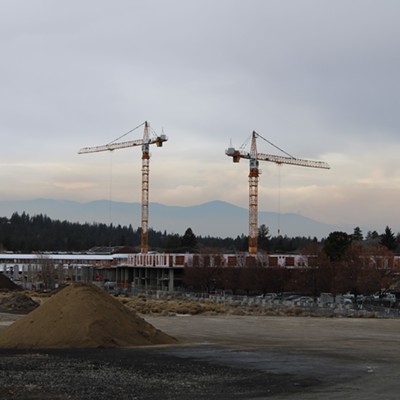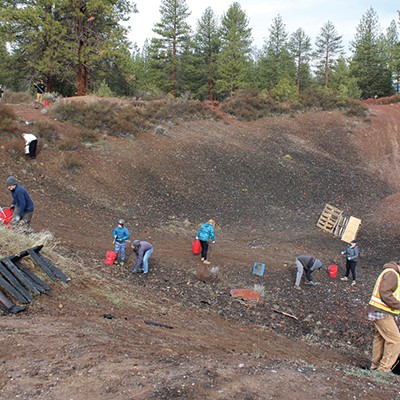For years, the city of Bend staff has garnered accolades for its drinking water quality, its water conservation efforts and ecosystem restoration initiatives. But a much-publicized project to revamp the city's aging surface water delivery system has put all aspects of the city's water management strategy under the microscope. Critics are pushing the city to reconsider a recent decision to pursue a $73-million upgrade of its Bridge Creek surface system and say the city has underestimated the costs of continuing to divert millions of gallons per day from Tumalo Creek while ignoring the potential for a large-scale surface water restoration project in the basin by returning some or all of its surface water rights to Tumalo Creek. There, it would benefit fish and wildlife and help boost flows in the middle Deschutes River.
Last month, the state's foremost water use watchdog group, Portland-based WaterWatch waded into the murky fray when it filed a formal complaint with the state Department of Water Resources, which manages Oregon's surface and groundwater supply by issuing new permits for wells and surface diversions and policing existing users. According to WaterWatch's complaint, the city has been pulling more than its fair share of surface water from Bridge Creek then diverting some of that water back to the river system more than 10 miles downstream at Tumalo Creek near the city's surface water plant. While the city doesn't contest the underlying facts, the staff has defended its practice as being within the state guidelines for water use and blasted WaterWatch's complaint as a red herring. In an unusual public rebuttal, city staff wrote:
"The timing of the complaint is concurrent with the efforts of WaterWatch and others to get the Council to rescind approval of the Surface Water Improvement Project. It seems the complaint is intended as a means of ratcheting up the pressure against the City maintaining a surface water system."
WaterWatch of Oregon attorney Kimberley Priestley said that while WaterWatch is concerned about the city's surface water decision, the complaint is a response to recent information that it obtained about how much water the city diverts into surface water system and the fact that not all of that water ends up in customers hands. There's also another problem with the set-up, the returning water, which is sent through a man-made ditch back into Tumalo Creek, often gathers mud and other debris that pollutes Tumalo. One such event occurred this past November, turning Tumalo Creek chocolate brown and prompting the interest of the Oregon Department of Environmental Quality, which has the authority to issue fines for such contamination.
WaterWatch isn't the only group to blast the city's surface-water plan. The multi-million dollar upgrade has drawn fire from a cross section of critics ranging from environmental groups to community and business leaders, including Old Mill Developer Bill Smith. Two city councilors, Oran Teater and Jim Clinton, an unlikely pair if there ever was one, voted against the plan to move ahead with the surface water re-vamp, saying the city council needed to take more time to study the questions raised by critics, including how several city-commissioned studies have produced vastly different cost estimates. Later this month, the OSU-Cascades campus will host a surface water forum that will further explore the issues surrounding the surface water project. The controversy underscores the friction surrounding all questions of future water use and supply in the basin where municipalities, agricultural interests and conservationists often publicly endorse mutual benefit and compromise, but privately look after their best interests.
In the case of Bend's surface water project, one of the foremost criticisms leveled is that the city has failed to account for the economic benefit of returning some or all of the Bridge Creek stream flow to the watershed. Depending on the time of year, this could range from about five to 10 million gallons per day. That's a significant amount of water in a basin where state and federal agencies and conservation groups like the Deschutes Water Conservancy and the Upper Deschutes Watershed Council have spent millions of dollars on stream flow and habitat restoration over the past decade and a half. Just how much the city's water right is worth and whether anyone would be willing to acquire it for stream flow restoration purposes is an open question.
"It's a subject of some debate, but it ain't zero," said Bill Buchanan, a local attorney with Karnopp Petersen who has emerged as one of the city's foremost critics on the water plan.
"Whether it's a million or $30 million, we don't know. But to say it's worth zero is to say you haven't looked at it," said Buchanan, who entered the surface water controversy out of a personal interest rather than a professional one.
Over the past year and a half, Buchanan has collected hundreds, if not thousands, of pages of documents that he keeps in a stack of folders. He has information on stream flows, city water usage and also reams of calculations that he says contravene many of the city's key economic assumptions about cost of converting its surface water system to a ground water system. Such a system, said Buchanan, would be cheaper and more ecologically sensible than maintaining a surface water system that requires an extensive upgrade and a new costly treatment system to meet federal drinking water standards.
In November, City Manager Eric King criticized Buchanan's advocacy after Buchanan and others raised questions about the city's decision to hire its surface water consultant, which by the city's own estimate stood to make between $12 and $18 million on the surface water project, to prepare a cost comparison of the long term outlook of surface versus ground water systems. Perhaps not surprisingly, the surface water consultant, HDR engineering, found that surface water was more economically attractive. Buchanan says that HDR made several faulty assumptions that led to that finding, including vastly overestimating the cost of electricity based on future rate increases. HDR also assumed that the wells would be located in southeast Bend where there is no existing water infrastructure rather than at the city's existing southwest Bend Outback site where there is additional capacity. King pointed out at the time that Buchanan was an attorney not an engineer.
If the city appears to be treating Buchanan more like an adversary than a concerned citizen, it's understandable. Buchanan has tangled with the city before on a water-related issue and the scrape left a few scars on city hall. Buchanan was the attorney who represented southeast Bend developer Jan Ward in a successful lawsuit against the city after it condemned Ward's private water system in the Mountain High neighborhood. The ensuing legal battle led to the closure of the Mountain High golf course and a successful judgment against the city of Bend for more than $10 million. Buchanan is quick to point out that the Mountain High condemnation case and the surface water project are two very different animals. However, he sees some similarities in the city's narrowly focused approach and its unwillingness to listen to outside viewpoints.
The city eventually offered an olive branch to Buchanan and other critics by asking its newly convened infrastructure advisory committee to review the city council's decision to proceed with the surface water upgrade. The meeting that resulted from that decision, however, was less than productive, said Buchanan. The city hired a mediator to run the session, which Buchanan said consisted of a long lecture from the city's handpicked advisory committee with little opportunity for dialogue. City communication director Justin Finestone said the city opted to bring in the mediator to keep the meeting organized.
"From our point of view, we just wanted to make sure that it ran on time and ran smoothly," Finestone said.
For Buchanan, the meeting confirmed that city staff and council have no interest in reconsidering their decision to invest in the surface water upgrade, a project that will bump the city of Bend water customers' bills by as much as 45 percent in the next five years.
The unfortunate result, Buchanan said, is a missed opportunity to move to a more stable and cost-efficient groundwater-based system while undertaking a historic river flow restoration that would benefit generations to come. Buchanan points out that councilor Mark Capell keeps likening the Bridge Creek project to Drake Park, in so far as it is an investment that will benefit the community for years to come. That's ironic, Buchanan said, because the city does have a chance to create a legacy, but it's not in the form of water treatment plant or a new pipeline. It's in a restored river that will run through an actual park, namely Shevlin, he said. As fate would have it, that water would eventually run around Awbrey Butte, spilling into the Deschutes River right in the area where the Bend parks district recently spent almost $3 million to acquire another new property for a regional park along the river.
"I'm anticipating that sometime in my life we'll see Shevlin connected to Sawyer Park through a series of trails that run through an urban growth boundary... in a way that enhances Bend and having restored stream flows adds some panache to Bend that is comparable to the dedication of Drake Park," Buchanan said.
But don't count on the city to take the plunge.





















